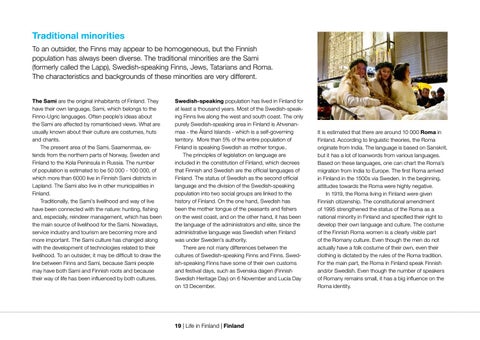Traditional minorities To an outsider, the Finns may appear to be homogeneous, but the Finnish population has always been diverse. The traditional minorities are the Sami (formerly called the Lapp), Swedish-speaking Finns, Jews, Tatarians and Roma. The characteristics and backgrounds of these minorities are very different. The Sami are the original inhabitants of Finland. They have their own language, Sami, which belongs to the Finno-Ugric languages. Often people’s ideas about the Sami are affected by romanticised views. What are usually known about their culture are costumes, huts and chants. The present area of the Sami, Saamenmaa, extends from the northern parts of Norway, Sweden and Finland to the Kola Peninsula in Russia. The number of population is estimated to be 50 000 - 100 000, of which more than 6000 live in Finnish Sami districts in Lapland. The Sami also live in other municipalities in Finland. Traditionally, the Sami’s livelihood and way of live have been connected with the nature: hunting, fishing and, especially, reindeer management, which has been the main source of livelihood for the Sami. Nowadays, service industry and tourism are becoming more and more important. The Sami culture has changed along with the development of technologies related to their livelihood. To an outsider, it may be difficult to draw the line between Finns and Sami, because Sami people may have both Sami and Finnish roots and because their way of life has been influenced by both cultures.
Swedish-speaking population has lived in Finland for at least a thousand years. Most of the Swedish-speaking Finns live along the west and south coast. The only purely Swedish-speaking area in Finland is Ahvenanmaa - the Åland Islands - which is a self-governing territory. More than 5% of the entire population of Finland is speaking Swedish as mother tongue.. The principles of legislation on language are included in the constitution of Finland, which decrees that Finnish and Swedish are the official languages of Finland. The status of Swedish as the second official language and the division of the Swedish-speaking population into two social groups are linked to the history of Finland. On the one hand, Swedish has been the mother tongue of the peasants and fishers on the west coast, and on the other hand, it has been the language of the administrators and elite, since the administrative language was Swedish when Finland was under Sweden’s authority. There are not many differences between the cultures of Swedish-speaking Finns and Finns. Swedish-speaking Finns have some of their own customs and festival days, such as Svenska dagen (Finnish Swedish Heritage Day) on 6 November and Lucia Day on 13 December.
19 | Life in Finland | Finland
It is estimated that there are around 10 000 Roma in Finland. According to linguistic theories, the Roma originate from India. The language is based on Sanskrit, but it has a lot of loanwords from various languages. Based on these languages, one can chart the Roma’s migration from India to Europe. The first Roma arrived in Finland in the 1500s via Sweden. In the beginning, attitudes towards the Roma were highly negative. In 1919, the Roma living in Finland were given Finnish citizenship. The constitutional amendment of 1995 strengthened the status of the Roma as a national minority in Finland and specified their right to develop their own language and culture. The costume of the Finnish Roma women is a clearly visible part of the Romany culture. Even though the men do not actually have a folk costume of their own, even their clothing is dictated by the rules of the Roma tradition. For the main part, the Roma in Finland speak Finnish and/or Swedish. Even though the number of speakers of Romany remains small, it has a big influence on the Roma identity.
